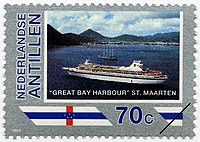Postage stamps and postal history of the Netherlands Antilles
This is a survey of the postage stamps and postal history of the postal areas Netherlands Antilles as well as its predecessor Curaçao. The area consisted of the islands Bonaire, Saba and Sint Eustatius (now part of the Netherlands as postal area "Caribbean Netherlands") as well as Sint Maarten, Curaçao and Aruba (which each are separate postal areas).
Early mail service in the islands of the

Curaçao (1873-1950)
The first postage stamps of Curaçao (the name was used for the six islands collectively when the areas was named Curaçao and Dependencies and Territory of Curaçao) were issued 23 May 1873;[1] they depicted William III in profile, and were inscribed "CURAÇAO", as were all issues for the next 77 years. The six original values (21⁄2c to 50c) were joined by a 2.50-gulden value in 1879, a 121⁄2c in 1886, and four more values in 1889. All of these were issued without gum (due to the heat and humidity) until 1890.

In 1889 a longstanding tradition began with the issuance of low-value (1c to 5c) stamps showing only a large numeral. In 1891 the 30c value was surcharged 25c. Meanwhile, the passing of William left his daughter Wilhelmina to be among the youngest persons depicted on a stamp to that date, with five values appearing between 1892 and 1896. Only the vignette actually changed.

Additional surcharges were needed periodically; 21⁄2c in 1895, and in 1901/1902 they were applied to stamps of the

In 1915 a new series reused designs from the

The first commemorative stamps, in 1923, celebrated Wilhelmina's 25th anniversary, depicting her with a finely-engraved portrait. The portrait was reused in the definitive series of 1928, which added a steamship to the bottom of the design.
In 1934, a series of 17 types marked the 300th anniversary of the colony; designs included portraits of figures significant in history, plus a view of
1936 saw a new definitive series, with the usual lower values as numerals, now vertical in an oval frame, while from 10c on up was a profile of Wilhelmina wearing a sort of shawl or veil drawn back; a depiction of the Queen not seen any other stamps of the Dutch area.

The 40th anniversary issue in 1938 and the definitives of 1941/1942/1947 reverted to the use of the same profiles of Wilhelmina as the Netherlands and the Netherlands Indies.
A set of 15
A 1948 set of 11, showing white-haired Wilhelmina in profile, quickly became dated as Queen Juliana was invested with the crown in September; she appeared on a pair of stamps commemorating the occasion in September.

Netherlands Antilles (1950-2010)


The name of the colony officially changed in 1949, and was first inscribed in two stamps issued in October for the 74th anniversary of the UPU. The name change also entailed new definitives, which began appearing in 1950, using the same design as issued for the Netherlands the previous year, but inscribed "NED. ANTILLEN".
A handful of commemoratives appeared during the 1950s, and then 1958 new definitives adopted a simple and artistic designs representing the different islands. The designs continued in use for many years, with new sets of (higher) values supplementing the originals in 1973 and 1977.
The numbers of stamps issued each year gradually crept upward, but still at a relatively restrained pace. The focus of issues was generally on local wildlife and tourism themes.
After Aruba obtained the status of country in the Kingdom of the Netherlands, it formed its own postal area.
After the dissolution
After the Dissolution of the Netherlands Antilles, three issuing identities formed: Curaçao, Sint Maarten and the Caribbean Netherlands.[2]
See also
- Postage stamps and postal history of Aruba
- Postage stamps and postal history of the Caribbean Netherlands
- Postage stamps and postal history of Curaçao
- Postage stamps and postal history of Sint Maarten
- Postage stamps and postal history of the Netherlands
References and sources
- References
- ISBN 0356108627
- ^ "Netherlands Antilles | Stamps and postal history | StampWorldHistory". Archived from the original on 2018-03-03. Retrieved 12 August 2018.[title missing]
- Sources
- Frank W. Julsen and A. M. Benders, A Postal History of Curaçao and the other Netherlands Antilles (The Hague: Van Dieten, 1976) The most comprehensive work on the subject.
- Stanley Gibbons Ltd: various catalogues
- AskPhil – Glossary of Stamp Collecting Terms
- Encyclopaedia of Postal History






